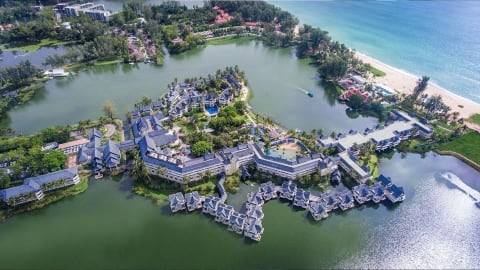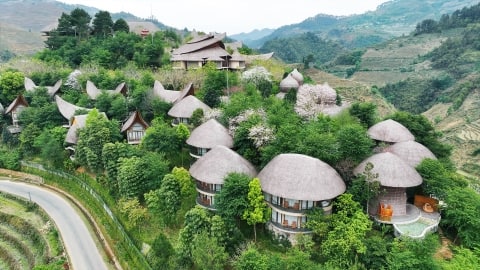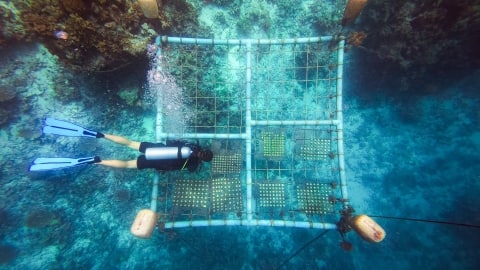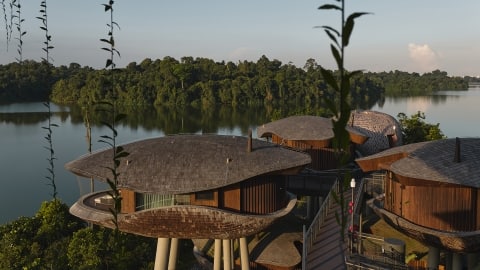From the balconies of Mandai Rainforest Resort by Banyan Tree, the view stretches over jungle canopy and reservoir waters, not the high-rises or highways that travellers might expect from an urban jungle such as Singapore.
Our resort is nestled within the lush greenery of the Mandai Wildlife Reserve, Singapore’s integrated wildlife and nature destination. Situated beside the reserve's leading wildlife parks, we offer guests an immersive experience with nature and conservation. Far from the skyscrapers and city lights, this may seem like an unexpected setting for a resort by Singaporean standards, but it feels familiar to us, having spent three decades creating spaces where nature and community frame the experience for both guests and associates.

This is more than a new resort — it is our 100th. And our first in Singapore, marking a homecoming for us.
After 31 years and 99 openings abroad, our Group has finally established a resort here. For our Founders Ho Kwon Ping and Claire Chiang, both Singaporean, the milestone is a reaffirmation of the values that have guided them from the start: that hospitality, at its best, strengthens the land, the lives of local communities, and the experiences of guests alike.
From neglected land to a thriving community
Those values were first tested in the early 1990s, when the couple purchased a plot of degraded coastal land in Phuket.
The site was a disused tin mine, its soil poisoned by years of extraction. Instead of walking away, they planted 7,000 trees and began restoring the land.
In time, the site became Banyan Tree Phuket, our group’s first property and a proof of concept for a different kind of tourism.
“We had to build something from nothing,” recalls Ho.

That first project reshaped the area. What had once been barren is now Laguna Phuket, a network of hotels, residences, schools, and lagoons that has become both a destination and a thriving community. Migratory birds returned to the wetlands. Families built livelihoods around the tourism industry that began to flourish here.
“We wanted to bring out that real sense of place,” says Ho, “wherever you are.”
Growth that goes beyond borders
Our group has grown far and wide since then, to destinations such as Morocco, Mexico, and China. Expansion was less about planting flags and more about rooting a philosophy.
In Vietnam’s lush northwest region, guests can join eco-walks through rice terraces and bamboo forests at Garrya Mù Cang Chải. At Banyan Tree Higashiyama Kyoto in Japan's cultural heart, they meditate with Buddhist monks. At Banyan Tree Ringha in China’s Shangri-La region, they stay in reimagined Tibetan farmhouses and learn black pottery from local masters.

“The slogan we began with – empowering people, embracing the environment – is not just about sustainability. Everything that we do is in that phrase,” says Chiang.
That purpose is visible in initiatives such as Stay for Good, which involves guests directly in ecological or cultural initiatives. Through this programme, guests can connect more deeply with the destinations they visit, where they can not just observe, but actively participate in the local community.
At Banyan Tree Vabbinfaru in the Maldives, for example, guests dive into the blue, joining marine biologists in monitoring reefs. At Cassia Bintan in sunny Indonesia, visitors plant mangrove trees and return years later to see their growth.

“We ask guests why they come to the Banyan Group, and very often the response is about our sustainability or the way we operate – it is purposeful. They don’t just come for rooms or spas. They come because they want to be engaged in something,” says Chiang. Discover more about our marine conservation, how we empower local communities, and how we provide opportunities for our guests to travel with purpose.
Communities at the core
For our associates – who Ho and Chiang say are more like family members than employees – the impact is often tangible.
Long-time associate Charoenporn Sinthathongchai witnessed firsthand how the area transformed around Bang Tao. “Things changed after Banyan Tree was built,” she recalls. “More people came. People’s lives improved. Before that, this area was desolate.”
This philosophy has led to more than direct employment.

The Seedlings training programme equips disadvantaged youth with language skills, mentorship, and work placements. From Bintan to Vietnam, employees such as Bùi Thị Nhân, Sustainability Officer at Banyan Tree Lăng Cô, have turned internships into full-time roles. Banyan Tree Gallery, meanwhile, connects local artisans with global travellers to sustain craft traditions and livelihoods.
“If we can do something good in this industry, we have the opportunity to make a greater impact on many people,” says Environmental Naturalist Henry Singer of his work in Bintan.
A return in spirit
Mandai Rainforest Resort by Banyan Tree is part of this same continuum. Designed with biophilic principles, the property draws from the layers of the rainforest – forest floor, understorey, canopy. While many Banyan Group properties have been brought to life by Co-founder and Chief Architect Ho Kwon Cjan – Ho’s brother and lifelong collaborator – this resort was designed by Singaporean firm WOW Architects, and won the 2025 SIA Design Award.

Some rooms face the reservoir. Others are embedded in greenery. The resort sits alongside the Singapore Zoo, Bird Paradise, Night Safari, River Wonders, and Rainforest Wild Asia, placing guests inside a conservation landscape rather than apart from it.
Here, guests are also encouraged to participate in what makes the area special, whether through nature walks, photography workshops that document biodiversity, or programmes highlighting Singapore’s dual role as city and habitat.
For a nation often seen through its skyline of concrete and glass, the setting is a reminder that Singapore’s natural heritage is just as vital.
Carrying the legacy forward
Across 100 properties, expansion has been less about hotels than empowering communities and nurturing ecosystems.
“The legacy I hope we can leave behind is that, at its core, this is a family business with family values,” says Ho. “That community feeling is what we exist to perpetuate.”
Mandai Rainforest Resort by Banyan Tree makes that legacy visible at home. It is a hotel, yes, but also a statement that hospitality can be grounded in stewardship, and that growth can serve both guests and the places they inhabit.
A hundred properties in, we have shown that travel can be more than consumption. It can be a collaboration with ecosystems, cultures, and people.
And with Mandai Rainforest Resort by Banyan Tree, we have stayed true to our roots.
